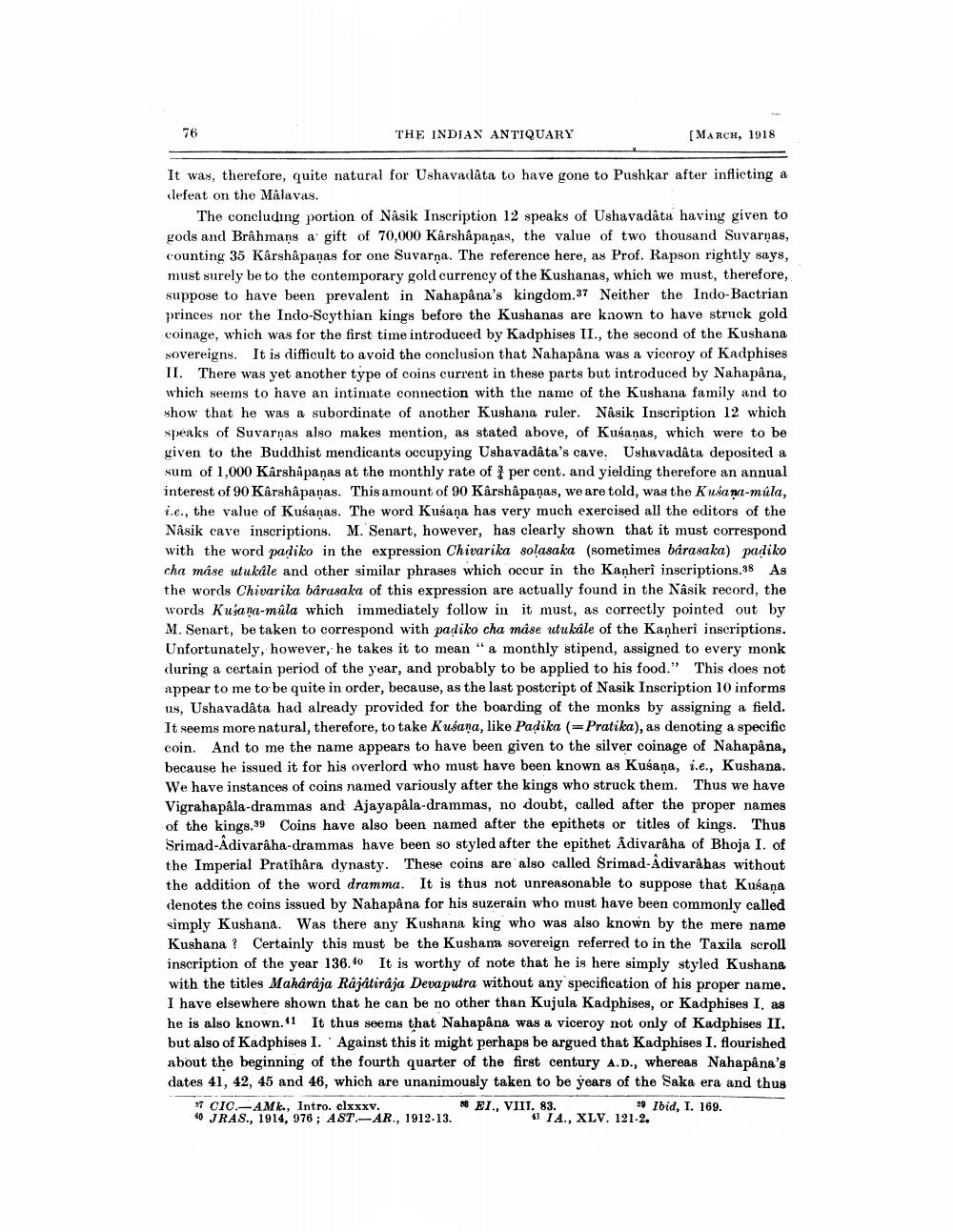________________
THE INDIAN ANTIQUARY
[MARCH, 1918
It was, therefore, quite natural for Ushavadâta to have gone to Pushkar after inflicting a defeat on the Malavas.
The concluding portion of Násik Inscription 12 speaks of Ushavadå ta having given to gods and Brâhmans a gift of 70,000 Kârshậpaņas, the value of two thousand Suvarmas, counting 35 Kârshapanas for one Suvarna. The reference here, as Prof. Rapson rightly says, must surely be to the contemporary gold currency of the Kushanas, which we must, therefore, suppose to have been prevalent in Nahapâna's kingdom.37 Neither the Indo-Bactrian princes nor the Indo-Scythian kings before the Kushanas are kaown to have struck gold coinage, which was for the first time introduced by Kadphises II., the second of the Kushana sovereigns. It is difficult to avoid the conclusion that Nahapâna was a viceroy of Kadphises II. There was yet another type of coins current in these parts but introduced by Nahapana, which seems to have an intimate connection with the name of the Kushana family and to show that he was a subordinate of another Kushana ruler. Nâsik Inscription 12 which speaks of Suvarnas also makes mention, as stated above, of Kušanas, which were to be given to the Buddhist mendicants occupying Ushavadâta's cave. Ushavadâta deposited a sum of 1,000 Kârshậpaņas at the monthly rate of 1 per cent. and yielding therefore an annual interest of 90 Kârshapanas. This amount of 90 Kärshapaņas, we are told, was the Kusana-múla, i.e., the value of Kusaņas. The word Kuśana has very much exercised all the editors of the Nasik cave inscriptions. M. Senart, however, has clearly shown that it must correspond with the word padiko in the expression Chivarika solasaka (sometimes bárasaka) padiko cha mase ulukale and other similar phrases which occur in the Kanheri inscriptions.38 As the words Chivarika bárusaka of this expression are actually found in the Nâsik record, the words Kusana-múla which immediately follow in it must, as correctly pointed out by M. Senart, be taken to correspond with padiko cha mase utu kále of the Kanheri inscriptions. Unfortunately, however, he takes it to mean " a monthly stipend, assigned to every monk during a certain period of the year, and probably to be applied to his food." This does not appear to me to be quite in order, because, as the last postcript of Nasik Inscription 10 informs us, Ushavadâta had already provided for the boarding of the monks by assigning a field. It seems more natural, therefore, to take Kusana, like Padika (=Pratika), as denoting a specific coin. And to me the name appears to have been given to the silver coinage of Nahapana, because he issued it for his overlord who must have been known as Kusana, i.e., Kushana. We have instances of coins named variously after the kings who struck them. Thus we have Vigrahapala-drammas and Ajayapala-drammas, no doubt, called after the proper names of the kings.39 Coins have also been named after the epithets or titles of kings. Thus Srimad-Adivarâha-drammas have been so styled after the epithet Adivarâha of Bhoja I. of the Imperial Pratihâra dynasty. These coins are also called Srimad-Adivarahas without the addition of the word dramma. It is thus not unreasonable to suppose that Kusana denotes the coins issued by Nahapana for his suzerain who must have been commonly called simply Kushana. Was there any Kushana king who was also known by the mere name Kushana? Certainly this must be the Kushana sovereign referred to in the Taxila scroll inscription of the year 136.40 It is worthy of note that he is here simply styled Kushana with the titles Maharaja Rajátiraja Deva putra without any specification of his proper name. I have elsewhere shown that he can be no other than Kujula Kadphises, or Kadphises I. as he is also known. It thus seems that Nahapana was a viceroy not only of Kadphises II. but also of Kadphises I. 'Against this it might perhaps be argued that Kadphises I. flourished about the beginning of the fourth quarter of the first century A.D., whereas Nahapana's dates 41, 42, 45 and 46, which are unanimously taken to be years of the Saka era and thus 37 CIC.-AME., Intro. clxxxv.
* EI., VIIT. 83.
99 Ibid, 1. 169. 40 JRAS., 1914, 976; A ST.-AR., 1912-13.
4) 1 A., XLV. 121-2.




